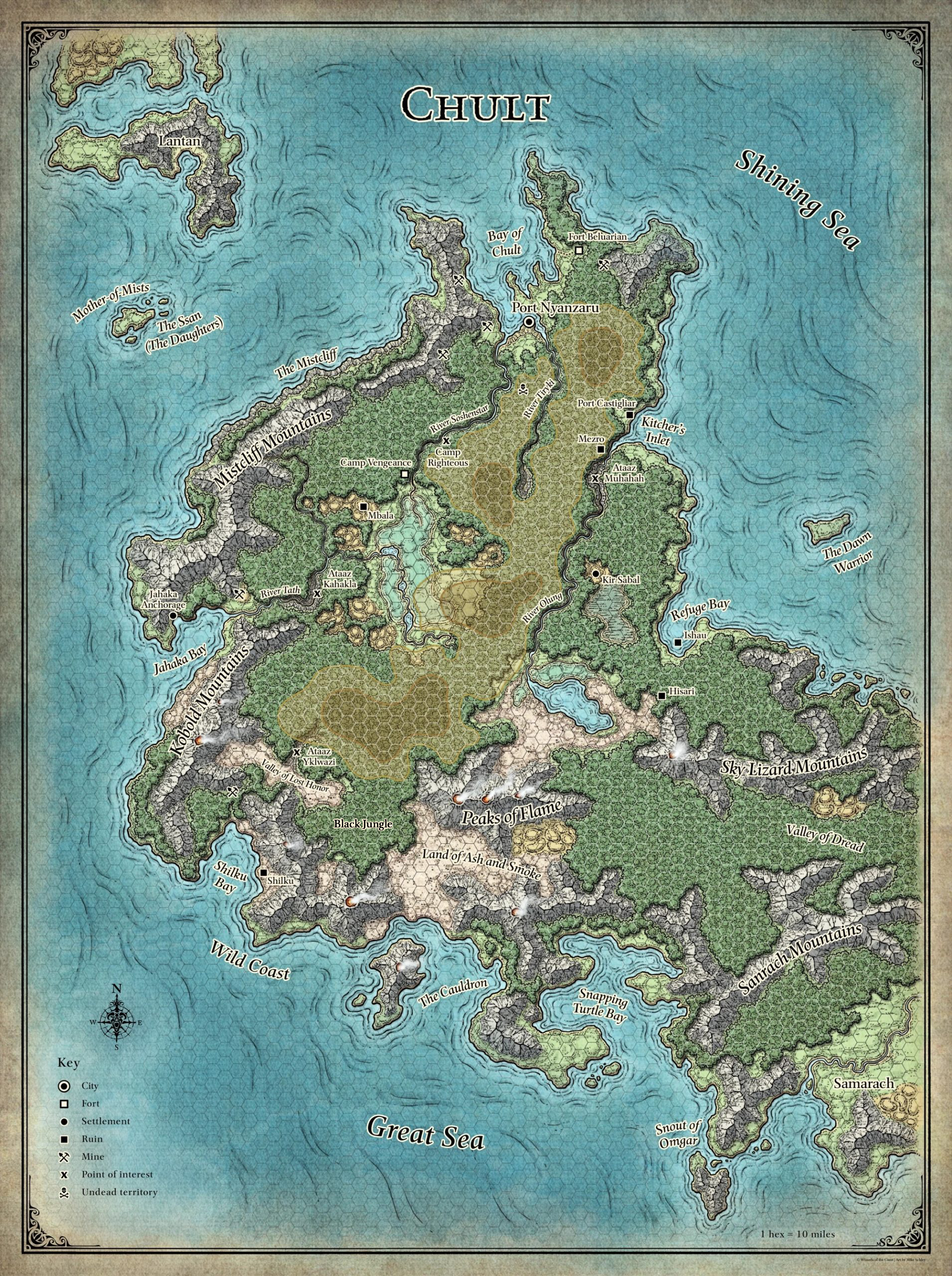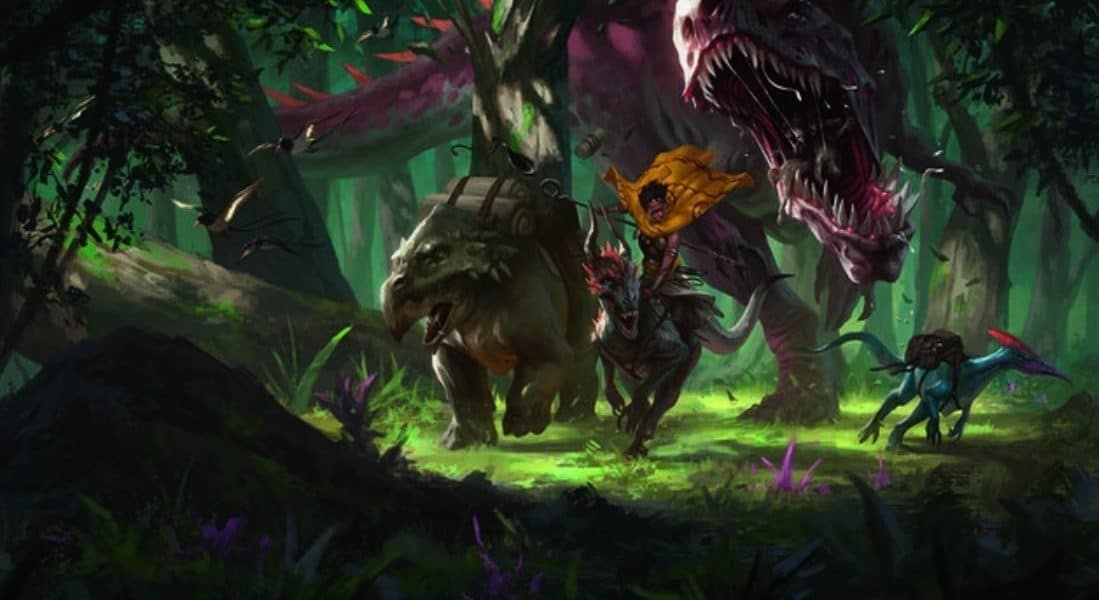Chult is located in southwestern Faerûn: at the westernmost end of the Chultan peninsula, in the southern part of the Trackless Sea, off the coast of Calimshan. As a result of the Spellplague, Chult was cut off from the mainland, becoming an island, but following the second Sundering, it was reunited with the mainland. Regardless of geographical status, Chult has always been remote and isolated, forming a mountainous jungle of savage beasts, hulking dinosaurs, and disease-ridden swamps. Humanoid tribes, batiri goblins, an undead army, and even stranger monstrous folk haunt the thick jungles. Nevertheless, Chult draws adventurers who seek its legendary riches. The primordial deity Ubtao is almost exclusively revered in the land, for the divine powers of Faerûn awarded Ubtao the dominion over the land of Chult in exchange for the deity’s vigilance over the threat from under the Peaks of Flame.
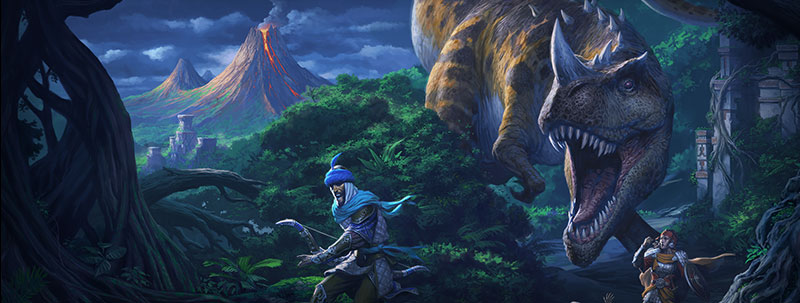
![]()
Inhabitants
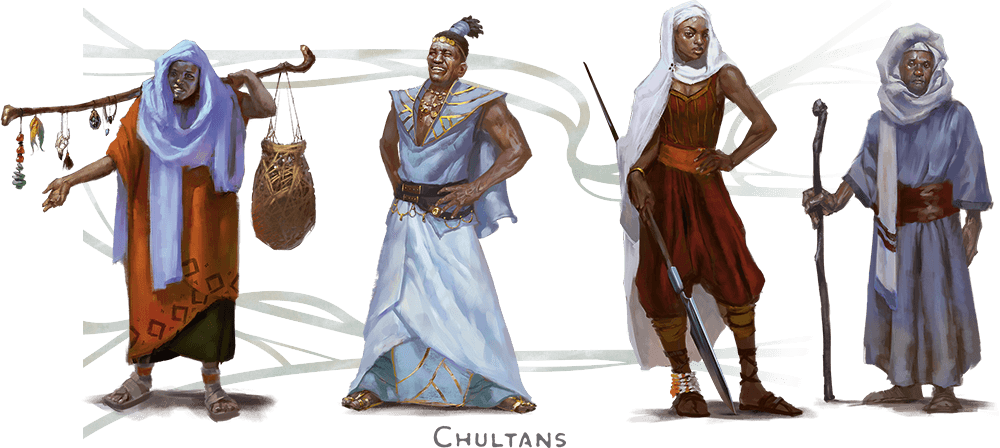 Most humans of the Chultan Peninsula live in tribal communities, consisting of a dozen or so families, which move from one area to the next when the poor soil of the largely jungle-covered peninsula becomes depleted. The villages are named for their clan, which is in turn named after important heroes or tribal spirits. Chultan villages consist of circular huts formed from a ring of saplings tied together to form a dome. The walls are formed from woven saplings and large leaves cover the roofs. Most villages also include a clan meeting house for the leading council of elders, a village altar, and any family shrines. Most rural Chultans wear simple loin cloths and survive by a combination of hunting and foraging. Those living in the savannah also farm and herd cattle.
Most humans of the Chultan Peninsula live in tribal communities, consisting of a dozen or so families, which move from one area to the next when the poor soil of the largely jungle-covered peninsula becomes depleted. The villages are named for their clan, which is in turn named after important heroes or tribal spirits. Chultan villages consist of circular huts formed from a ring of saplings tied together to form a dome. The walls are formed from woven saplings and large leaves cover the roofs. Most villages also include a clan meeting house for the leading council of elders, a village altar, and any family shrines. Most rural Chultans wear simple loin cloths and survive by a combination of hunting and foraging. Those living in the savannah also farm and herd cattle.
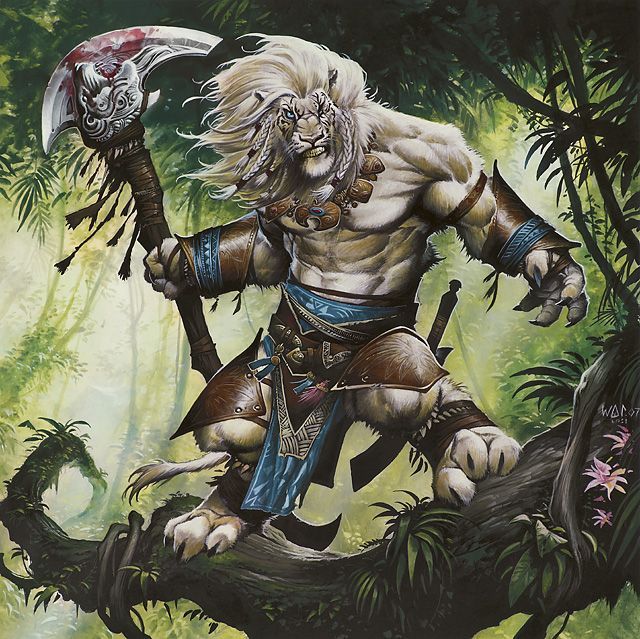 Iron and steel are rare in Chult, so native Chultans rarely make use of such metals. Armor is rarely worn because of the climate. Their weapons are made of copper, obsidian, stone, or wood, and their warriors wear hide breastplates and carry large, colorful, oval-shaped hide shields, called “hlang”. Common weapons include the “yklwa” (a short spear), the “kerrie” (a knobbed club), handaxes, daggers, short swords, scimitars, long bows, and hunting spears. Cavalry among the Chultans is unheard of.
Iron and steel are rare in Chult, so native Chultans rarely make use of such metals. Armor is rarely worn because of the climate. Their weapons are made of copper, obsidian, stone, or wood, and their warriors wear hide breastplates and carry large, colorful, oval-shaped hide shields, called “hlang”. Common weapons include the “yklwa” (a short spear), the “kerrie” (a knobbed club), handaxes, daggers, short swords, scimitars, long bows, and hunting spears. Cavalry among the Chultans is unheard of.
Magic is generally feared, and each tribal-family generally has only one wielder of arcane magic, who performs hunting ceremonies and brews potions to aid the hunters. Subsequently, the Chultan attitude towards the arcane causes some arcanists to flee into the jungle to practice their art alone. In the days before the Spellplague, many also traveled to study in Mezro.
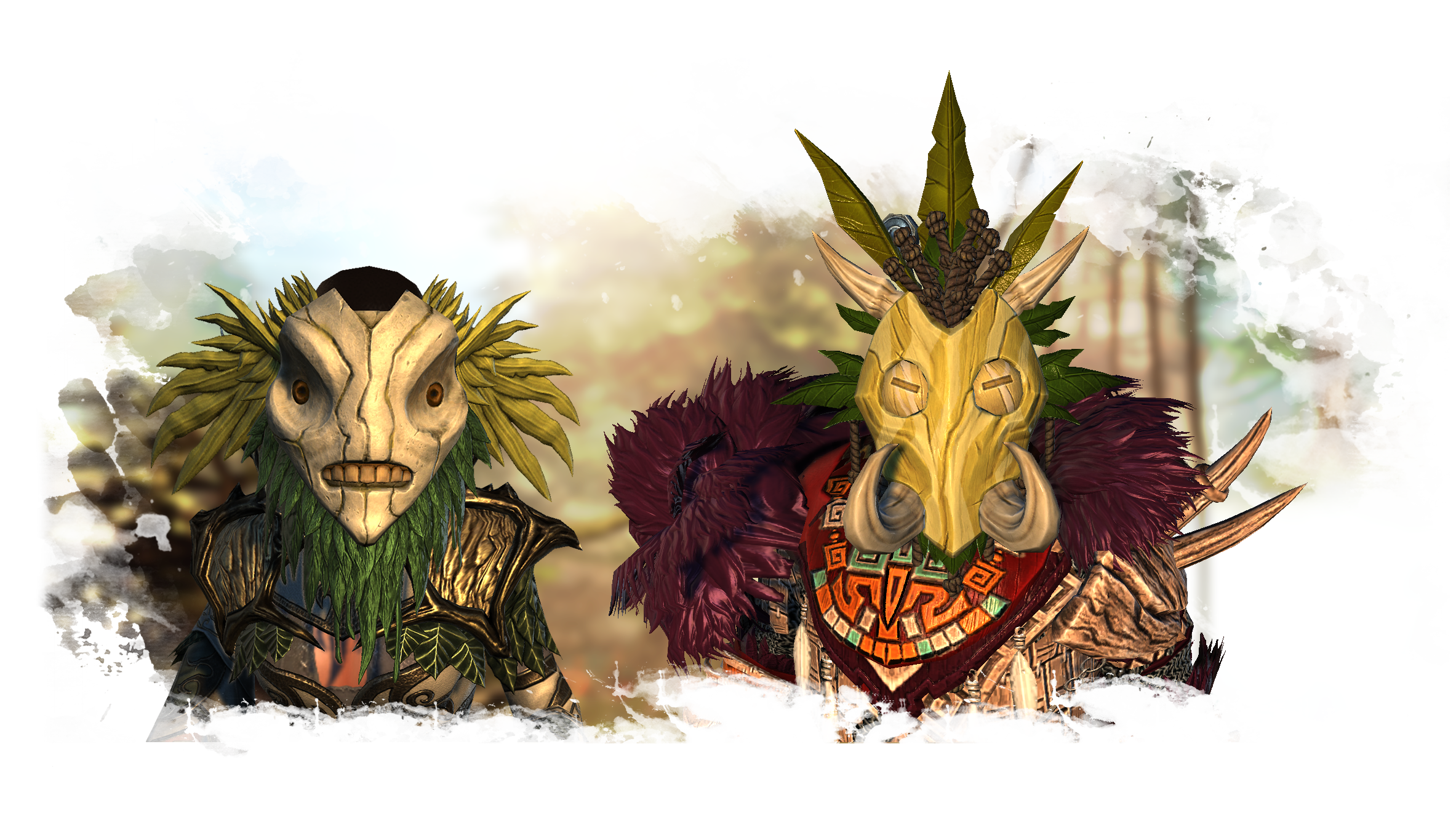
Aside from humans, tabaxi, yuan-ti, wild dwarves, batiri goblins, aldani, pterafolk, bullywugs, and lizardfolk also inhabit the land. Exotic creatures as chuuls, hydras, nagas, troglodytes, trolls, and wyverns exist in smaller numbers. The dominant predators of the land are the dinosaurs, who are worshiped by many of the natives.
![]()
History
Chultan humans were originally from a continent southeast of Maztica and southwest of Zakhara, known only as “The Dark Continent” or Katashaka. In −2809 DR, a group of humanoids, including feline tabaxi and the human Aldani, Eshowe and Thinguth tribes, traveled from their homes on the Dark Continent to Faerûn. These tribes were led by couatls, who taught them about the god Ubtao. Upon arriving in Chult, they were met by Ubtao at the Peaks of Flame. The Thinguth settled in what became known as Thindol, near the middle of the peninsula, the Aldani towards the western tip, and the Eshowe between the two.
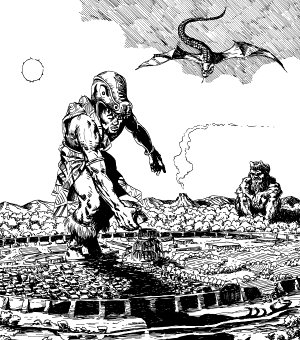
Ubtao building the city of Mezro, while the dwarven god Thard Harr looks on. His enemies also observe, as Sseth flies overhead and Eshowdow creeps along the ground.
The Chultan holy city of Mezro was founded by Ubtao himself in −2637 DR. The city was built along the River Olung, which served as its southern and eastern borders, while thick jungle was found on the west and north. Mezro was circular and divided into four quarters by wide avenues, stemming from the Temple of Ubtao at the center.
According to legend, some of the Aldani tribe overfished for lobsters in the Aldani Basin, causing Ubtao to curse them for their greed by turning them into lobsterfolk. In shame, the remaining Aldani took the name of their greatest warrior, Chult, as their own.
In −438 DR, a war erupted between the Chultan and Eshowe tribes that continues until this day.
Around the time of Netheril’s collapse, an avatar of Set appeared in the jungles of Chult as a yuan-ti abomination with gargantuan wings. The avatar, called Sseth, forged a yuan-ti empire, called Serpentes, that stretched from the Black Jungles in the west to the eastern extent of the Mhair Jungles, enslaving the emerging human cultures of the region. In its early days, the empire’s capital city of Omu prospered through mining and commerce. Its riches and power led to greed, as the city demanded offerings from its neighbors in the form of slaves to work the mines.
Serpentes, the yuan-ti empire, dominated the Chultan peninsula for several centuries before Sseth disappeared and Serpentes collapsed without his leadership. The slaves revolted against their oppressors and the city fell to ruin. Signs of the once-great society, its currency and maps showing its location, were purposefully destroyed. It truly became the Forgotten City. The city’s lack of an overseeing deity drew the attention of primal spirits from the jungle. They offered power to scattered Omuans that remained, in exchange for their veneration. The Omuans promptly destroyed their temples to Ubtao and worshiped the brutal and discordant spirits, who became known as the nine trickster gods. Since they were not true deities, they could not grant spells to all their clerics, and they demanded sacrifices and blood trials to test their subjects’ resolve and entertain the decadent population.
In −137 DR, the Eshowe unleashed Eshowdow, the “Shadow of the Eshowe”, and the shadow giant sacked Mezro. This ancient evil has been theorized to be a part of Ubtao’s essence that had been corrupted by the goddess Shar. In revenge, one of the seven Chosen of Ubtao (known as barae) of Mezro, Ras (Duke) Nsi, began a genocide of the remaining Eshowe people in his zeal to protect his city. By −122 DR, the Eshowe were essentially extinct; for this, Nsi was exiled by the other six barae.
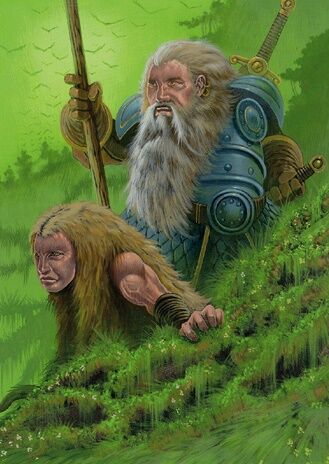 Ras Nsi transformed his four-towered mansion, complete with low defensive walls, stained-glass windows, waving banners, and white stone, into a literal moving palace, raising it on a massive platform to be carried by twenty-four gigantic tortoises. Nsi controlled a massive slave army, including wild dwarven, batiri goblin, human, and pterafolk. Filling the void left by the fall of Serpentes, Nsi sent bands of his army around Chult to collect taxes from the villages to fund his crusade. Under the guise of the “Refuge Bay Trading Company”, Nsi also raised money to fund his goals by the sale of slaves and lumber to the other countries of Faerûn. This latter activity resulted in the destruction of great spans of rainforest. He made use of earth elementals and dinosaurs to uproot and transport the large trees. The slaves and lumber were taken to Refuge Bay and shipped using his personal fleet.
Ras Nsi transformed his four-towered mansion, complete with low defensive walls, stained-glass windows, waving banners, and white stone, into a literal moving palace, raising it on a massive platform to be carried by twenty-four gigantic tortoises. Nsi controlled a massive slave army, including wild dwarven, batiri goblin, human, and pterafolk. Filling the void left by the fall of Serpentes, Nsi sent bands of his army around Chult to collect taxes from the villages to fund his crusade. Under the guise of the “Refuge Bay Trading Company”, Nsi also raised money to fund his goals by the sale of slaves and lumber to the other countries of Faerûn. This latter activity resulted in the destruction of great spans of rainforest. He made use of earth elementals and dinosaurs to uproot and transport the large trees. The slaves and lumber were taken to Refuge Bay and shipped using his personal fleet.
Ras Nsi believed that his army would be used to serve and defend Mezro, the city he still loved, despite his banishment from it. He bided his time, assuming that when a future disaster would come to Mezro, the other barae would call him home to aid them. The barae, however, feared and felt threatened by Nsi’s growing power, and so took drastic action: The entire city of Mezro became invisible around 863 DR, made possible by a magical wall that was raised around it. Not only did the wall render the city invisible, but it also caused magical confusion to whomever came too close to its walls. It remained hidden like this for nearly 500 years, until 1363 DR, when the barae decided to lower the magical defenses after a solid victory against Nsi’s army. After that time, travelers were once again welcomed in the city, and it saw a surge in growth and trade.
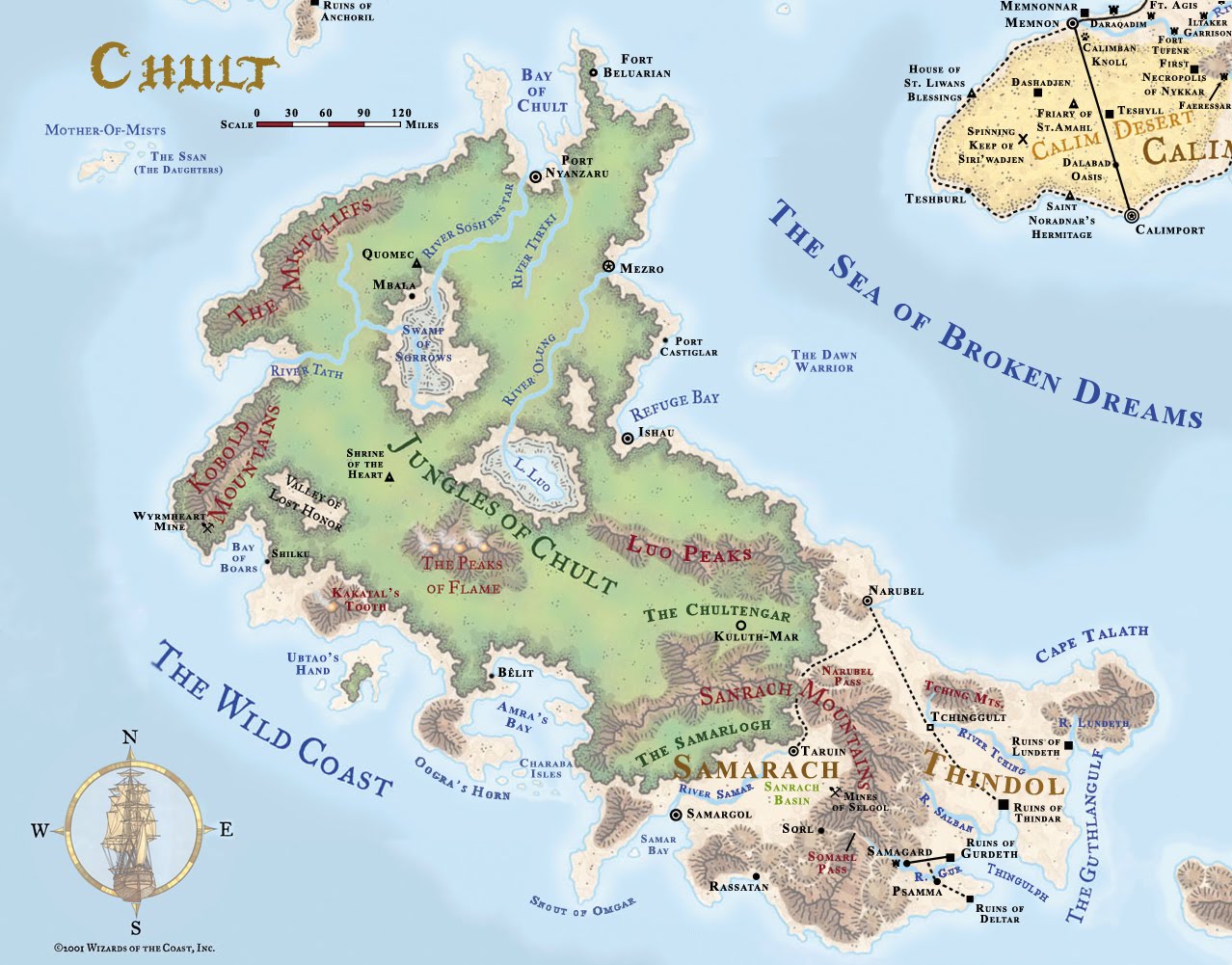 In The Year of Blue Flame, 1385 DR, when the Spellplague struck the world, a great cataclysm separated the Chultan Peninsula from the rest of the continent, leaving it an island. At the same time, now some thousand years or more since the fall of Serpentes, three yuan-ti tribes still struggled for dominance over the Black Jungles: the Sesehen tribe was the largest and most powerful, but the Eselemas and Jennestas tribes formed a loose alliance with the remaining human Eshowe tribe. The Eshowe had come into possession of a powerful artifact, and leveraged their yuan-ti alliance to take control of a portion of Omu and rededicated an ancient Yuan-ti temple to Shar, calling it the Night Fane.
In The Year of Blue Flame, 1385 DR, when the Spellplague struck the world, a great cataclysm separated the Chultan Peninsula from the rest of the continent, leaving it an island. At the same time, now some thousand years or more since the fall of Serpentes, three yuan-ti tribes still struggled for dominance over the Black Jungles: the Sesehen tribe was the largest and most powerful, but the Eselemas and Jennestas tribes formed a loose alliance with the remaining human Eshowe tribe. The Eshowe had come into possession of a powerful artifact, and leveraged their yuan-ti alliance to take control of a portion of Omu and rededicated an ancient Yuan-ti temple to Shar, calling it the Night Fane.
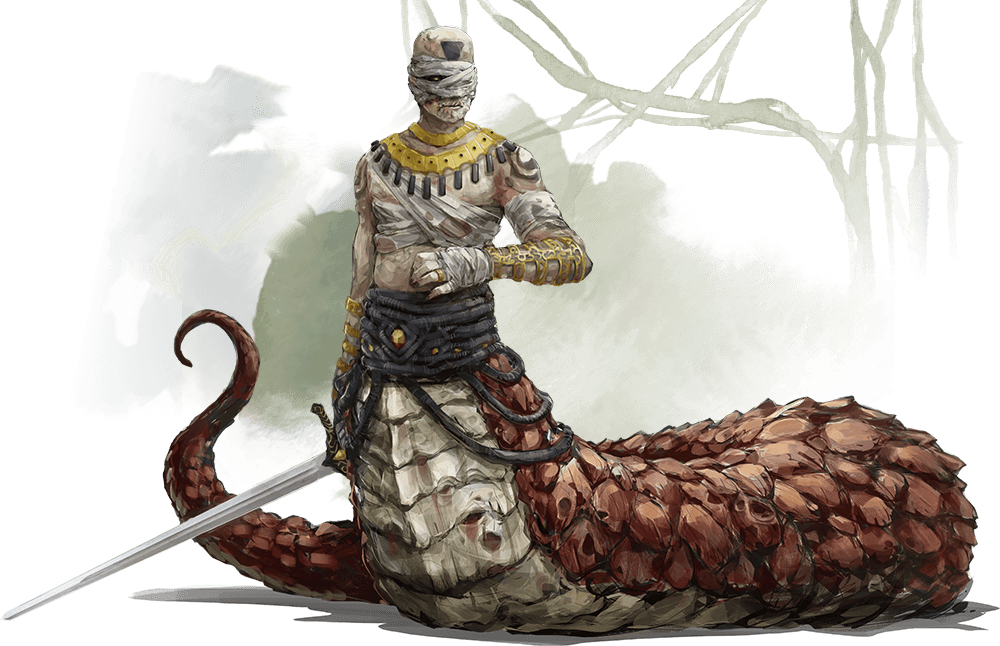 During the Spellplague’s cataclysm, the yuan-ti abomination leader of the Sesehen tribe was killed. Ras Nsi, fleeing from Mezro, undertook a ritual to transform into a malison and became the leader of the group. Learning of the Eshowe—Yuan-ti alliance, Nsi led his new yuan-ti tribe to Omu and slaughtered his ancient enemies. Using the power of the artifact from the Night Fane, Ras Nsi raised his defeated army from the dead, flooding the jungles with zombies and skeletons. In the Year of the Walking Man (1390 DR), soon after Nsi’s raising of his undead army, Lord Vanrak Moonstar of Waterdeep led a treasure-seeking expedition into the Black Jungles with his friend Glyster. They found Omu, and fought their way into the Night Fane. Using some powerful magic items, Lord Vanrak retrieved the artifact stored there, but not before the loss of nearly his entire contingent. Lord Vanrak and Glyster nearly escaped Ras Nsi’s return to the temple, and then only because Glyster had a powerful advantage.
During the Spellplague’s cataclysm, the yuan-ti abomination leader of the Sesehen tribe was killed. Ras Nsi, fleeing from Mezro, undertook a ritual to transform into a malison and became the leader of the group. Learning of the Eshowe—Yuan-ti alliance, Nsi led his new yuan-ti tribe to Omu and slaughtered his ancient enemies. Using the power of the artifact from the Night Fane, Ras Nsi raised his defeated army from the dead, flooding the jungles with zombies and skeletons. In the Year of the Walking Man (1390 DR), soon after Nsi’s raising of his undead army, Lord Vanrak Moonstar of Waterdeep led a treasure-seeking expedition into the Black Jungles with his friend Glyster. They found Omu, and fought their way into the Night Fane. Using some powerful magic items, Lord Vanrak retrieved the artifact stored there, but not before the loss of nearly his entire contingent. Lord Vanrak and Glyster nearly escaped Ras Nsi’s return to the temple, and then only because Glyster had a powerful advantage.
For decades, Mezro held back the waves of undead sent forth by Ras Nsi. To save the city from destruction during the upheaval of the Sundering, the barae created a demiplane and transported their city and all its citizens there. They left behind artificial ruins to discourage Ras Nsi and every other troublemaker to find what really happened to the city. Oscar Montantis, a Doomguide of Kelemvor, is a native Chultan who learned this truth after communing with the Lord of the Dead. For the rest of the world, Mezro was destroyed during the Sundering. By 1492 DR, the artificial ruins of Mezro were an undead- and monster-infested site, used by members of the Flaming Fist company from Baldur’s Gate as training grounds for their forces in Chult.
![]()
Locations
Jungles
It is said by many that the jungles of Chult are the most dangerous places in Faerûn. The plants are intelligent predators while the predators themselves are massive and armed with huge teeth and claws. Insects bite and sting travelers almost constantly, the heat and humidity are almost unbearable, and the undergrowth contains a multitude of poisonous snakes. Worst, however, is the disease that runs rampant in the area. Most things in the jungle have some sort of illness or parasite, and it is very easy to catch such illnesses off them. Even the water is tainted and has to be boiled if it is to be drunk. On top of all this, the intelligent creatures that eke out an existence in the dense foliage are perfectly happy—and sometimes go out of their way—to track travelers in order to hunt them down and kill them. Yuan-ti, batiri goblins, and other species that have learned to survive in this place need food; adventurers tend to suit that need nicely.
One of the greatest dangers of Chult is the Undead that infested it. Yet the adventurers keep on traveling in droves to the Chultan jungles, as rumors of endless veins of gold, huge gems and ruined empires stuffed to the brim with magic and riches keep surfacing in taverns across Faerûn… and many were willing to brave the dangers of the jungle for a slice of that fabled wealth.
Regions
- The Aldani Basin is a huge, swampy drainage basin in the middle of the jungles of Chult. The rivers Tath and Soshentar flow from lakes found within it. The basin received its name from the Aldani “lobsterfolk” living there.
- The Black Jungles are a portion of the southern Chultan jungles that receive their name from the layer of ash continuously falling on them from the Peaks of Flame. It was once the western reach of the Serpentes empire.
- The Land of Ash and Smoke is so choked by the winds from the Peaks of Flame that the jungle cannot grow here, unlike the Black Jungles on the Peaks’ other side.
- The Mistcliff Mountains form the northwestern edge of the peninsula, leveling out only briefly before forming cliffs along the ocean. The Mistcliffs are home to one of the few major colonies of aarakocra in all of Faerûn.
- The Peaks of Flame are three active volcanoes and the abode of salamanders and other creatures of flame. The Peaks are also said to sit over a pair of iron doors that lead to the Fugue Plane, the world of the dead. Legend has it that, at the end of the world, Dendar the Night Serpent would tear down these doors and break through into the world.
- Snapping Turtle Bay gets its name from the most prevalent creatures in its waters. One of them is rumored to be as big as a house. He’s known as King Toba, and his shell has gemstones embedded in it.
- The Snout of Omgar is a mountainous island along the southern Chultan coast that marks the boundary between Chult and the coast of Samarach. The Snout is the domain of the tortle race.
- The Valley of Dread is a 50-mile-wide valley nestled between the Sky Lizard Mountains and the Sanrach Mountains. This place is regarded by humans and serpentfolk alike as a place of death, and it effectively divides the Jungles of Chult from the rest of the Chultan Peninsula, with the ziggurat of Kuluth-Mar sitting squarely in the middle of the valley.
- The Valley of Lost Honor lays in the southwest, once the last refuge of the Eshowe before they were destroyed. Legends say that all of their wealth was left behind in caves in the valley, while more sinister legends claim the evil deity of Eshowdow, resides there, recruiting followers and planning revenge.
- The Wild Coast is a jagged and treacherous coast of southwestern Chult that creates a hazard for ships, and merchants from northern Faerûn have learned to give it wide berth. Fearing not only the cliffs, sailors speak of whirlpools, freak storms, aquatic monsters, flying dinosaurs and giant eagles. A few brave (or foolish) fortune hunters seek to explore the caves along the coast, hoping they will lead into rich mines under the jungle.
Notable Locations
- Ataaza Muhaha, meaning Laughing Gorge in the Chultan language, is a canyon over 100 feet deep on the River Olung. It is crossable only by the Monkey Bridge, near the site of Mezro. The gorge is inhabited by troops of monkeys that hoot, howl and shriek incessantly. The echoes of these sounds resonate along its depth, forming sounds that remind most Faerûnians of malevolent laughter.
- Ataaz Yklwazi, meaning Gorge of Blades in the Chultan language, is a volcanic canyon located north of the Valley of Lost Honor. The gorge earns its name from jagged shards of basalt that shoot up from the ground, resembling the Chultan short spears known as yklwas.
- Camp Righteous was an Order of the Gauntlet military outpost in Chult that was established, and destroyed, during the 15th century DR. The camp was located on the River Soshenstar in the northern regions of the Chultan jungles. It was built around the Chultan structure known as the House of the Crocodile.
- Ishau was a sunken village located at the bottom of Refuge Bay in Chult, tavern tales say sea hags navigate through the ruins looking for treasure or the remains of the dead.
- Mbala was a town located northwest of the Aldani Basin, the plateau that it lay upon was 1,800 feet tall and its base was surrounded by heaps of huge boulders. Once the seat of a small Chultan kingdom, it is now a ghost town.
- Mezro was the largest civilized area in Chult and a holy city to the tabaxi and human Chultan tribes. The city was generally peaceful and few people, except for outsider-adventurers, carried weapons. The city was protected by the undying barae of Ubtao, paladin-like chosen who also ruled the city. Over the course of the Spellplague, they held of waves of Ras Nsi’s undead, only for the city to be destroyed during the Sundering. The ruins are now an undead- and monster-infested site, used by members of the Flaming Fist as training grounds for their forces in Chult.
- Omu, also known as the Forbidden City, is the ruined capital of the yuan-ti Serpentes empire. It was located in a basin surrounded by cliffs in the heart of the Chultan jungle, making it extremely difficult to find. The last of the Eshowe allied with two tribes of yuan-ti to take control of a portion of the city and establish the Night Fane temple, only to be defeated by Ras Nsi.
- Port Castigliar was a small settlement in Chult, tucked away in a rarely visited part of Refuge Bay. Lacking a dock or any place to moor a ship or boat of any size, it was a port in name only. The graveyard was said to be more densely populated than the lands around it for up to 5 miles… which may be the reason it was targeted by Ras Nsi, seeking to add numbers to his undead army.
- Shilku was a ruined coastal town, located in the bay south of the Kobold Mountains, about 100 miles from the Valley of Lost Honor. Some time before the end of the 15th century DR, the town was decimated by activity from the nearby volcanoes. In a unique turn of events, the town was actually entirely preserved by the volcanic activity, as many of Skilku’s buildings were encased in volcanic rock.
Settlements
- Camp Vengeance is the forward camp for the Order of the Gauntlet for their operations in Chult, following the loss of Camp Righteous to the undead. The camp is located on the western bank of the River Soshenstar, just a few miles north of the Aldani Basin.
- Fort Beluarian is a small outpost that belongs to the Flaming Fists, a mercenary company based in Baldur’s Gate. The troops work with adventurers to promote the cause of good, and provide shelter to adventurers in dire need. In spite of this goodwill, the city was, over the course of the Spellplague, burnt to the ground twice by local inhabitants of Chult only to be rebuilt by the Baldurians. The colony is also in competition with the much larger Port Nyanzaru. The fort presently contains a prison, often holding dangerous inmates, dissidents, and P.O.W.s. Some in Port Nyanzaru and the larger Amnian empire have labeled Fort Beluarian a “penal colony,” a charge that Baldur’s Gate vehemently denies.
- Kir Sabal is a cliffside monastery in Chult that is home to a flock of aarakocra monks, led by the elder, Asharra. Kir Sabal is nestled into the side of a massive plateau that overlooks the surrounding jungle canopy. It is only accessible on the ground by a series of sloping stone ramps and walkways.
- Port Nyanzaru is a harbor port settled by Amnians and a mighty fortress, built to withstand pirate attacks and the threats of the jungle itself. Having recently earned its independence, Nyanzaru is a booming, densely populated community that brings in much wealth for the peninsula.
![]()

